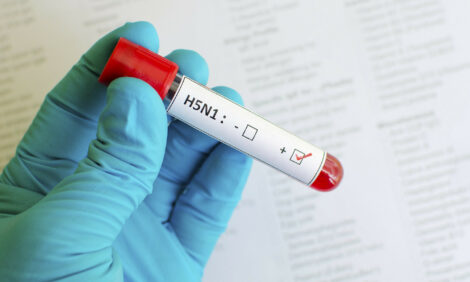



Avian Flu: the Greatest Risk Faced by the UK Poultry Industry?
ANALYSIS - With three outbreaks in the last year, avian influenza was a key topic at the recent Egg and Poultry Industry Conference (EPIC) for the UK poultry sector. Jackie Linden reports on several of the meeting’s key presentations on this topic for ThePoultrySite.There is a constant low risk of low-pathogenic avian influenza (LPAI) as the disease is endemic in wild birds and the virus is constantly circulating globally, warned Chief Veterinary Officer with the Department of the Environment, Food and Rural Affairs (Defra), Nigel Gibbens. Globally, occasional outbreaks of highly pathogenic AI (HPAI) come at a high cost to producers and some risk to human health, he said.
There were three unrelated outbreaks in the UK in the last year – two of HPAI and one LPAI – but thankfully, they were detected early and the virus did not infect further farms after each initial outbreak.
.JPG)
In contrast, the 223 outbreaks in the United States and loss of 48 million affected layers and turkeys this year had “devastating consequences” for the poultry industry there, he said.
Mr Gibbens stressed the need for poultry producers to protect their business using already well-known biosecurity measures, and for everyone in the industry to remain vigilant and to report any suspicion of disease to the Animal and Plant Health Agency (APHA) or other responsible authority.
“In the last year, there has been a massive worldwide impact of avian influenza,” said Andrew Jorêt of Noble Foods, representing the British Egg Industry Council (BEIC) and conference president. In the UK, one farm was hit in Lancashire in July as well as a Hampshire flock with low-pathogenic disease.
Following this experience, he said, a whole range of industry partners came together to review the situation and learn lessons for the future.

Among the main issues is “outbreak housing”; only free-range producers in the Protection Zone are required to keep their poultry housed. There is a lack of clarity over the status of those whose birds are further from the outbreak and the industry would like to see that area extended considerably for a period of around seven days while the outbreak is thoroughly investigated by Defra.
There are also concerns about the capability of Defra if there were to be multiple AI outbreaks requiring mass slaughter and disposal of birds, as occurred in the US this year. If infected farms are not dealt with quickly, they represent “an enormous virus factory”, he said, and spread the infection further.
Returning to the EPIC conference for a second year and adding his appreciation of the cooperation of the poultry industry following the most recent AI outbreaks, Secretary of State for Farming, Food and the Marine Environment, George Eustice, MP, confirmed the need to look at how wholesale gassing could be achieved where this is a practical solution in case of further cases.
The Minister agreed he had reservations about the need for such a long delay following secondary C&D before exports can resume.
AI has also highlighted aspects of biosecurity for an ideal poultry farm, stressed the Minister.
Ideally from the point of view of preventing all diseases, said Mr Jorêt, farms – even those that are not free-range - would be sited well away from any open water (and wild birds) and at least one mile from other poultry; have a perimeter fence with a single point of entry; minimise the number of visitors entering the farm, including feed delivery vehicles; have birds of single age and finally, buildings in good condition on a concrete apron so they can be kept clean and tidy. Interestingly, according to Mr Jorêt, outdoor access was not a major risk factor for AI in recent outbreaks in the UK or the US.
.JPG)
Mr Gibbens stressed that investigations following the AI outbreaks revealed the complexity of the contacts and relationships in the poultry industry. Using the HPAI outbreak in Lancashire as an example, he showed that this complexity adds to the complications of tracking and tracing the infection and regaining control of the situation.
Important is to identify the first cases in any outbreak. As it is known for AI viruses to mutate from a low-pathogenic to a highly pathogenic form, he recommended that farms test for viruses present on the farm so that risks can be better assessed.
At each stage, official measures and procedures need to be proportional to the risks under the specific circumstances, according to Mr Gibbens.
He also issued advice that everyone should prepare for any crisis that could disrupt their business - be that a disease, bad weather, breakdown with a supplier or any other adverse event. Every enterprise is different and it is vital to understand the risks that apply specifically to it. Even for biosecurity, where you are in the sector will affect the measures you need to take, he said.
It is also important to consider, for example, how the farm could carry out its critical activities and obtain essential supplies if it were to be placed under investigation for a notifiable disease or if it were to be included in a Protection Zone or Surveillance Zone.
Following an AI outbreak, the focus needs to be on retaining export markets and maintaining confidence of trading partners. This only starts when the C&D at the infected premises has been officially approved and then, under OIE rules, AI-free status cannot be restored for a period of 90 days, assuming no further outbreaks in the meantime. Exports to the European Union and some other countries can, by agreement, start earlier.
According to Mr Jorêt, the cost to the UK industry in lost profits from AI over the last year has reached UK£50 million, and this has led to discussion over the initiation of a supporting fund and/or insurance.
The industry is asking for government help in terms of guidance on how it might enforce payment of a levy and on capping the cost of re-insurance following a catastrophe.
Summing up, Mr Gibbens advised attendees to make preparations in a timely way ahead of an AI crisis: biosecurity needs to be appropriate for the risk factors on the particular premises, plans need to be in place on the basis that prevention is better than cure and finally, there needs to be coordination and cooperation across the whole supply chain.








